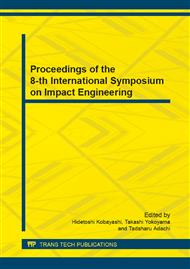p.238
p.244
p.250
p.256
p.262
p.268
p.274
p.281
p.286
Energy and Momentum Transfer to a Clamped Elastic Plate in an Air-Blast
Abstract:
The momentum transfer by a planar wave impinging upon a rigid, free-standing plate in water, a largely incompressible medium, is well understood [1]. Kambouchev et al. [2] extended the results of Taylor [1] to include the nonlinear effects of compressibility whilst Hutchinson [3] has recently addressed the issues of energy and momentum transfer to a rigid, free-standing plate. In this paper, key conclusions from the aforementioned studies are critically re-examined in the context of a `fully-clamped' elastic plate. The dynamic response of an elastic plate is represented by an equivalent single-degree-of-freedom (SDOF) system. A numerical method based on a Lagrangian formulation of the Euler equations of compressible flow and conventional shock-capturing techniques, similar to that employed in [2, 3], were employed to solve numerically the interaction between the air blast wave and elastic plate. Particular emphasis is placed on elucidating the energy and momentum transfer to a `fully-clamped' elastic plate compared to its rigid, free-standing counterpart, and on whether enhancement in the beneficial effects of FSI as a result of fluid compressibility remains and to what extent.
Info:
Periodical:
Pages:
262-267
Citation:
Online since:
June 2014
Price:
Сopyright:
© 2014 Trans Tech Publications Ltd. All Rights Reserved
Share:
Citation:


